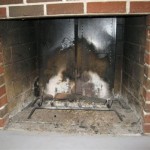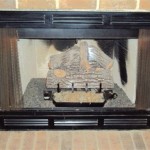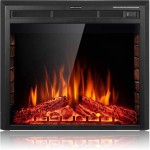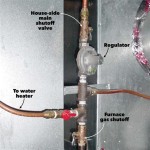Gas Log Fireplace Insert: Enhancing Comfort and Efficiency
Gas log fireplace inserts offer a convenient and aesthetically pleasing alternative to traditional wood-burning fireplaces. These inserts transform an existing masonry fireplace into a more efficient and user-friendly heating appliance. By utilizing natural gas or propane, they provide instant warmth, eliminate the need for firewood storage, and reduce air pollutants associated with burning wood.
The installation of a gas log fireplace insert involves placing a self-contained unit within the existing fireplace opening. This unit typically consists of a set of ceramic or refractory logs, a burner system, and a control valve. The insert is then connected to a gas supply line and vented to the outside, ensuring safe and proper combustion. A key factor in their appeal is the ability to replicate the ambiance of a wood-burning fire without the associated inconveniences.
Key Point 1: Efficiency and Heating Performance
One of the primary advantages of gas log fireplace inserts is their enhanced efficiency compared to traditional open-hearth fireplaces. Traditional fireplaces are notoriously inefficient, often drawing warm air from the room and sending it up the chimney along with the smoke. This results in a net loss of heat within the home and higher energy bills.
Gas log inserts, on the other hand, are designed to radiate heat directly into the room. Many models are equipped with features such as blowers, which circulate the heated air more effectively, distributing warmth throughout the space. The sealed combustion chamber also prevents the loss of heated room air up the chimney. The efficiency rating of a gas log insert indicates the percentage of fuel that is converted into usable heat. Higher efficiency ratings translate to lower energy consumption and reduced heating costs.
Furthermore, gas log inserts offer precise temperature control. With adjustable flame settings, users can easily regulate the heat output to suit their comfort level. This eliminates the guesswork associated with wood-burning fireplaces, where managing the fire and maintaining a consistent temperature can be challenging. They also allow zone heating by efficiently heating only the room the fireplace is in. This targeted heating approach can result in significant energy savings, especially in larger homes where heating the entire space may not be necessary.
The choice between vented and vent-free gas log inserts also impacts efficiency. Vented inserts, while producing a more realistic flame, exhaust combustion gases through the chimney, resulting in some heat loss. Vent-free inserts, conversely, burn cleaner and release heat directly into the room, achieving higher efficiency levels. However, vent-free models require proper ventilation within the room to ensure safe operation.
Key Point 2: Aesthetics and Convenience
Beyond their heating capabilities, gas log fireplace inserts offer a significant aesthetic upgrade to existing fireplaces. The ceramic or refractory logs are meticulously crafted to resemble real wood, complete with intricate details such as bark patterns, knots, and char marks. These logs are arranged to simulate a natural wood-burning fire, creating a visually appealing focal point in the room.
The convenience factor is another major draw for homeowners. Unlike wood-burning fireplaces, gas log inserts require no firewood procurement, storage, or handling. Starting a fire is as simple as flipping a switch or pressing a button on a remote control. This eliminates the effort and mess associated with wood-burning fires, such as hauling logs, building kindling, and cleaning up ashes.
Many gas log inserts come with programmable thermostats and remote control capabilities. These features allow users to set the desired temperature and operating schedule, providing automated heating and enhanced convenience. The remote control also enables users to adjust the flame height, turn the unit on and off, and control the blower speed from the comfort of their couch. The lack of ash and soot also means that extensive cleaning is unnecessary, significantly reducing the maintenance requirements. The fire can simply be switched off without any embers to worry about.
Furthermore, gas log inserts offer design flexibility. They are available in a wide range of styles and sizes to complement various architectural styles and room decors. From traditional to contemporary designs, there is a gas log insert to suit every aesthetic preference. The inserts can also be customized with different surrounds and decorative accessories to enhance the overall look of the fireplace.
Key Point 3: Safety and Environmental Considerations
Gas log fireplace inserts offer several safety advantages over traditional wood-burning fireplaces. The enclosed combustion chamber prevents sparks and embers from escaping, reducing the risk of accidental fires. The inserts are also equipped with safety features such as oxygen depletion sensors (ODS), which automatically shut off the gas supply if the oxygen level in the room drops too low. This prevents the build-up of carbon monoxide, a colorless and odorless gas that can be fatal.
Proper installation by a qualified technician is crucial to ensure the safe and reliable operation of a gas log fireplace insert. The technician will verify that the gas supply line is properly connected, the venting system is adequate, and the unit is operating according to manufacturer specifications. Regular maintenance, such as cleaning the burner and inspecting the venting system, is also essential to prevent malfunctions and ensure safe operation.
From an environmental perspective, gas log inserts offer a cleaner burning alternative to wood-burning fireplaces. While burning wood releases particulate matter and other pollutants into the atmosphere, gas log inserts produce significantly fewer emissions. Natural gas and propane are cleaner-burning fuels than wood, resulting in reduced air pollution and improved air quality. The use of gas log inserts can contribute to a more sustainable heating solution, particularly in areas where wood-burning restrictions are in place.
However, it is important to note that gas log inserts are not entirely emission-free. They still produce some carbon dioxide, a greenhouse gas that contributes to climate change. Vent-free models in particular can potentially impact indoor air quality, and should only be used in accordance with local codes and following manufacturer directions. It is advisable to choose a high-efficiency model and use it responsibly to minimize its environmental impact.
The cost of a gas log fireplace insert can vary depending on the size, features, and brand. Vented models are typically lower in price, as vent free models must be manufactured with tighter tolerances, better safety features and higher quality materials. Factors to consider include the cost of the insert itself, labor costs for installation, and the cost of running a gas line if one is not already in place. While the initial investment may be higher than a traditional fireplace, the long-term cost savings from improved efficiency and reduced maintenance can offset the initial expense.
In conclusion, gas log fireplace inserts provide a compelling combination of efficiency, aesthetics, convenience, and safety. They offer a practical and attractive way to upgrade an existing fireplace and enjoy the warmth and ambiance of a fire without the drawbacks of wood-burning. By carefully considering the various factors discussed above, homeowners can select a gas log insert that meets their specific needs and enhances their home environment.

Fireplace Insert Guide Fireplaces Direct Learning Center

The Top 3 Reasons To Choose A Gas Insert Over Log Set Hearthside Hearth Blog

Convert To Gas Installing Fireplace Inserts Doctor Flue

Rustic Gas Fireplace Inserts Kozy Heat

Gas Logs Vs Inserts What To Know Home Hearth Outfitters

Gas Fireplace Inserts

Gas Fireplace Inserts Portland Or Nw Natural Appliance Center

Propane Fireplace Inserts Gas Log Sets Tunkhannock Pa Ace Robbins

How Do Gas Logs Work Hocon

Gas Burning Fireplace Inserts We Install
Related Posts








